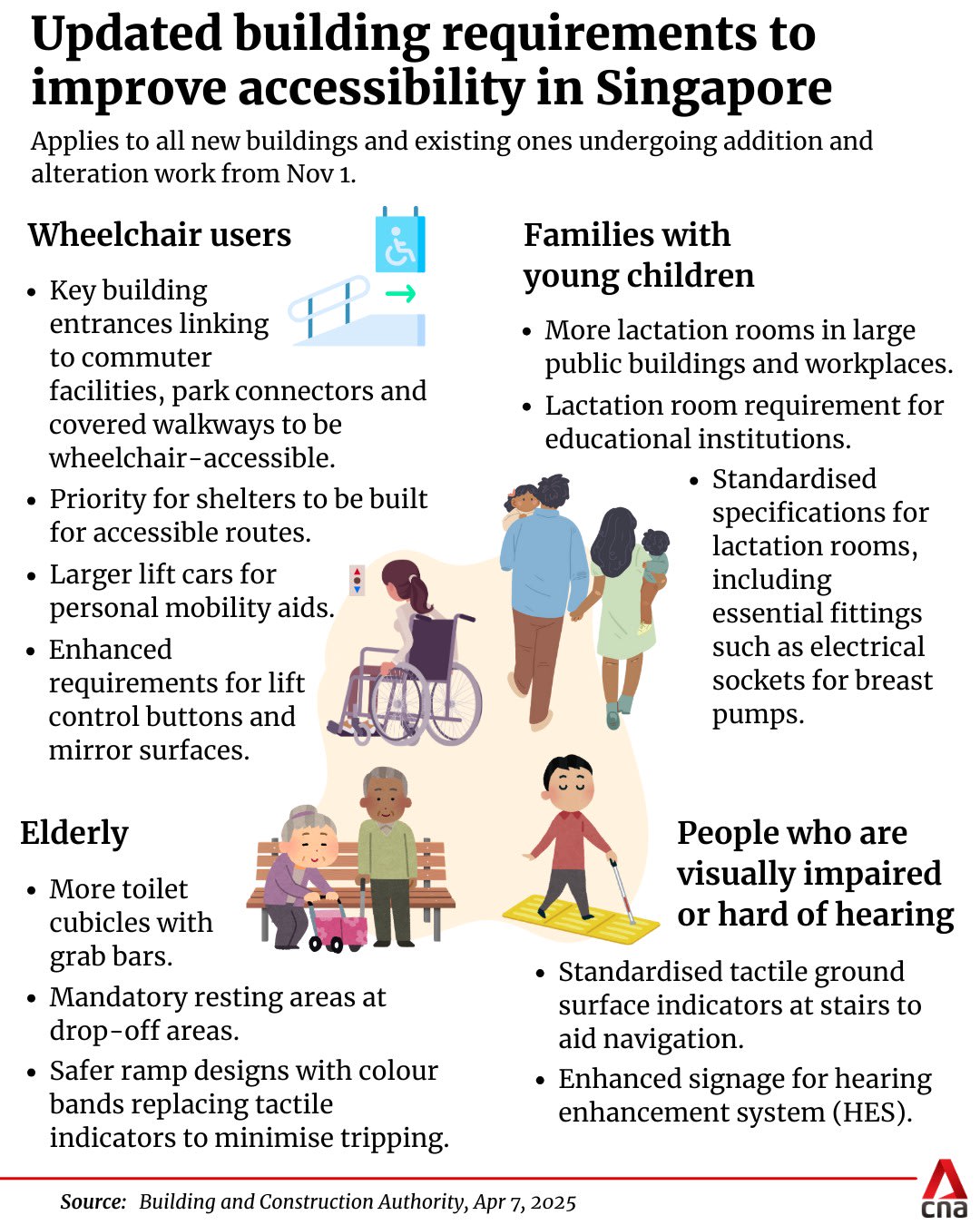Revised building codes to increase accessibility and support for nursing mothers, people with disabilities

Under this year's revision of the Code on Accessibility in the Built Environment, all key building entrances linking to neighbouring buildings, commuter facilities, park connectors, and covered walkways will need to be wheelchair-accessible. (Photo: Facebook/Indranee Rajah)

This audio is generated by an AI tool.
SINGAPORE: A revised building code will increase accessibility connections and support for people with disabilities, the elderly and nursing mothers, the Building and Construction Authority (BCA) announced on Monday (Apr 7).
The enhanced requirements to the Code on Accessibility in the Built Environment will apply to all new buildings undergoing addition and alteration works from Nov 1, BCA said in a media release.
The Code, first introduced in 1990, provides baseline standards for making buildings accessible to people with disabilities and other users. Around every five years, the Code undergoes a review to better meet the changing needs of the population.
This year’s revision, the sixth since the Code’s introduction, aims to address current gaps and to anticipate the future needs of persons with disabilities, the ageing population, and families with young children.
It introduces improvements for these user groups:
WHEELCHAIR USERS
i) Improving barrier-free interconnectivity
• All key building entrances linking to neighbouring buildings, commuter facilities, park connectors, and covered walkways to be wheelchair-accessible
• Priority for shelter to be built for accessible routes
ii) Enhanced provisions for accessible lifts in buildings
• Larger lift cars to accommodate personal mobility aids
• Enhanced requirements for lift control buttons and mirror surfaces
ELDERLY
• More toilet cubicles with grab bars
• Mandatory rest areas at drop-off points
• Safer ramp designs with colour bands replacing tactile indicators to minimise tripping
FAMILIES WITH YOUNG CHILDREN
• More lactation rooms in large public buildings and workplaces
• Lactation room requirement for educational institutions
• Standardised specifications for lactation rooms, with minimum size requirements and essential fittings such as electrical sockets for breast pumps
PERSONS WITH VISUAL IMPAIRMENT
• Standardised tactile ground surface indicators at stairs to aid navigation
PERSONS WHO ARE HARD-OF-HEARING
• Enhanced signage for hearing enhancement systems that operate with telecoil - a small wire built into a hearing aid that acts as a receiver. These must incorporate a “T” with the symbol of access to inform persons who are hard-of-hearing to activate their telecoil function.
In a Facebook post on Monday, Second Minister for National Development Indranee Rajah described the revision as a "significant step towards shaping a more inclusive Singapore".
“The updated standards will enhance our built environment, and make everyday spaces more welcoming and accessible to all,” she said.
“More than just enhancing infrastructure, it's also about enabling every individual to participate fully in society, move around safely and independently.”
This year’s revision was the result of a review committee formed in September 2023 - comprising representatives from social services agencies, industry stakeholders, academic institutions, government agencies and interest groups - to review the earlier version of the Code.
“The process included referencing international standards, analysing current design trends, and conducting detailed user trials,” said Minister for National Development Desmond Lee.
“It incorporates universal design concepts, and addresses the needs of persons with disabilities, elderly, and families with young children,” he said in a post on Facebook.
Executive Director of the Muscular Dystrophy Association (Singapore) Judy Wee, who has served on several Code review committees, expressed optimism about the changes.
“Through each review of the Code, we have seen tangible improvements in the built environment that enhance the daily lives of persons with disabilities, whether at work or leisure,” said Ms Wee.

STREAMLINED FOR INDUSTRY STAKEHOLDERS
The updated Code was also streamlined and reorganised in a more reader-friendly manner for built environment industry stakeholders.
It includes anthropometric information - measurements of the human body - of wheelchair users and other persons with disabilities. This provides clearer visualisation of the physical and spatial requirements for different users, enabling architects and designers to make more informed decisions, BCA said.
“Through the numerous engagements, we have been able to better understand and contribute ideas to improve the provisions within the Code,” said Real Estate Developers’ Association of Singapore member Jeffrey Wong.
“In addressing constraints faced by building owners and developers, we are glad that the enhanced Code has a renewed focus on catering to users of all ages and abilities”.
Having the new Code take effect from Nov 1 would give the industry sufficient time to "familiarise and ease themselves into the changes", said Mr Lee.
Owners of existing buildings who are keen to voluntarily upgrade their buildings with accessible facilities may consider tapping into BCA’s Accessibility Fund.
This provides co-funding for a wide range of user-friendly features such as the installation of lactation rooms or pods and wheelchair-accessible lifts, BCA said.
















